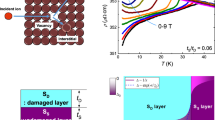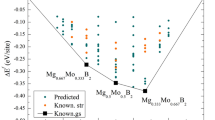Abstract
Magnesium diboride1 differs from ordinary metallic superconductors in several important ways, including the failure of conventional models2 to predict accurately its unusually high transition temperature, the effects of isotope substitution on the critical transition temperature, and its anomalous specific heat3,4,5. A detailed examination of the energy associated with the formation of charge-carrying pairs, referred to as the ‘superconducting energy gap’, should clarify why MgB2 is different. Some early experimental studies have indicated that MgB2 has multiple gaps3,4,5,6,7,8,9, but past theoretical studies10,11,12,13,14,15,16 have not explained from first principles the origin of these gaps and their effects. Here we report an ab initio calculation of the superconducting gaps in MgB2 and their effects on measurable quantities. An important feature is that the electronic states dominated by orbitals in the boron plane couple strongly to specific phonon modes, making pair formation favourable. This explains the high transition temperature, the anomalous structure in the specific heat, and the existence of multiple gaps in this material. Our analysis suggests comparable or higher transition temperatures may result in layered materials based on B, C and N with partially filled planar orbitals.
This is a preview of subscription content, access via your institution
Access options
Subscribe to this journal
Receive 51 print issues and online access
$199.00 per year
only $3.90 per issue
Buy this article
- Purchase on Springer Link
- Instant access to full article PDF
Prices may be subject to local taxes which are calculated during checkout




Similar content being viewed by others
References
Nagamatsu, J., Nakagawa, N., Muranaka, T., Zenitani, Y. & Akimitsu, J. Superconductivity at 39 K in magnesium diboride. Nature 410, 63–64 (2001)
Hinks, D. G., Claus, H. & Jorgensen, J. D. The complex nature of superconductivity in MgB2 as revealed by the reduced total isotope effect. Nature 411, 457–460 (2001)
Wang, Y., Plackowski, T. & Junod, A. Specific heat in the superconducting and normal state (2-300 K, 0-16 T), and magnetic susceptibility of the 38 K superconductor MgB2 . Physica C 355, 179–193 (2001)
Bouquet, F., Fisher, R. A., Phillips, N. E., Hinks, D. G. & Jorgensen, J. D. Specific heat of Mg11B2: evidence for a second energy gap. Phys. Rev. Lett. 87, 047001-1–047001-4 (2001)
Yang, H. D. et al. Order parameter of MgB2: a fully gapped superconductor. Phys. Rev. Lett. 87, 167003-1–167003-4 (2001)
Szabo, P. et al. Evidence for two superconducting energy gaps in MgB2 by point-contact spectroscopy. Phys. Rev. Lett. 87, 137005-1–137005-4 (2001)
Giubileo, F. et al. Two-gap state density in MgB2: a true bulk property or a proximity effect? Phys. Rev. Lett. 87, 177008-1–177008-4 (2001)
Chen, X. K., Konstantinovi, M. J., Irwin, J. C., Lawrie, D. D. & Franck, J. P. Evidence for two superconducting gaps in MgB2 . Phys. Rev. Lett. 87, 157002-1–157002-4 (2001)
Tsuda, S. et al. Evidence for a multiple superconducting gap in MgB2 from high-resolution photoemission spectroscopy. Phys. Rev. Lett. 87, 177006-1–177006-4 (2001)
Kortus, J., Mazin, I. I., Belashchenko, K. D., Antropov, V. P. & Boyer, L. L. Superconductivity of metallic boron in MgB2 . Phys. Rev. Lett. 86, 4656–4659 (2001)
An, J. M. & Pickett, W. E. Superconductivity of MgB2: covalent bonds driven metallic. Phys. Rev. Lett. 86, 4366–4369 (2001)
Bohnen, K.-P., Heid, R. & Renker, B. Phonon dispersion and electron-phonon coupling in MgB2 and AlB2 . Phys. Rev. Lett. 86, 5771–5774 (2001)
Yildirim, T. et al. Giant anharmonicity and nonlinear electron-phonon coupling in MgB2: a combined first-principles calculation and neutron scattering study. Phys. Rev. Lett. 87, 037001-1–037001-4 (2001)
Liu, A. Y., Mazin, I. I. & Kortus, J. Beyond Eliashberg superconductivity in MgB2: anharmonicity, two-phonon scattering, and multiple gaps. Phys. Rev. Lett. 87, 087005-1–087005-4 (2001)
Kong, Y., Dolgov, O. V., Jepsen, O. & Andersen, O. K. Electron-phonon interaction in the normal and superconducting states of MgB2 . Phys. Rev. B 64, 020501-1–020501-4 (2001)
Choi, H. J., Roundy, D., Sun, H., Cohen, M. L. & Louie, S. G. First-principles calculation of the superconducting transition in MgB2 within the anisotropic Eliashberg formalism. Phys. Rev. B 66, 020513-1–020513-4 (2002)
Eliashberg, G. M. Interactions between electrons and lattice vibrations in a superconductor. Zh. Eksp. Teor. Fiz. 38, 966–976 (1960); Sov. Phys. JETP 11, 696–702 (1960).
Allen, P. B. & Mitrović, B. in Solid State Physics (eds Ehrenreich, H., Seitz, F. & Turnbull, D.) Vol. 37 1–92 (Academic, New York, 1982)
Carbotte, J. P. Properties of boson-exchange superconductors. Rev. Mod. Phys. 62, 1027–1157 (1990)
Marsiglio, F., Schossmann, M. & Carbotte, J. P. Iterative analytic continuation of the electron self-energy to the real axis. Phys. Rev. B 37, 4965–4969 (1988)
Karapetrov, G., Iavarone, M., Kwok, W. K., Crabtree, G. W. & Hinks, D. G. Scanning tunneling spectroscopy in MgB2 . Phys. Rev. Lett. 86, 4374–4377 (2001)
Sharoni, A., Felner, I. & Millo, O. Tunneling spectroscopy and magnetization measurements of the superconducting properties of MgB2 . Phys. Rev. B 63, 220508-1–220508-4 (2001)
Rubio-Bollinger, G., Suderow, H. & Vieira, S. Tunneling spectroscopy in small grains of superconducting MgB2 . Phys. Rev. Lett. 86, 5582–5584 (2001)
Schmidt, H., Zasadzinski, J. F., Gray, K. E. & Hinks, D. G. Energy gap from tunneling and metallic contacts onto MgB2: possible evidence for a weakened surface layer. Phys. Rev. B 63, 220504-1–220504-4 (2001)
Takahashi, T., Sato, T., Souma, S., Muranaka, T. & Akimitsu, J. High-resolution photoemission study of MgB2 . Phys. Rev. Lett. 86, 4915–4917 (2001)
Buzea, C. & Yamashita, T. Review of superconducting properties of MgB2 . Supercond. Sci. Technol. 14, R115–R146 (2001)
Suhl, H., Matthias, B. T. & Walker, L. R. Bardeen-Cooper-Schrieffer theory of superconductivity in the case of overlapping bands. Phys. Rev. Lett. 3, 552–554 (1959)
Bardeen, J. & Stephen, M. Free-energy difference between normal and superconducting states. Phys. Rev. A 136, 1485–1487 (1964)
Acknowledgements
This work was supported by the National Science Foundation and by the Director, Office of Science, Office of Basic Energy Sciences of the US Department of Energy. Computational resources have been provided by the National Science Foundation at the National Center for Supercomputing Applications and by the National Energy Research Scientific Computing Center. H. S. acknowledges financial support from the Berkeley Scholar Program funded by the Tang Family Foundation.
Author information
Authors and Affiliations
Corresponding author
Ethics declarations
Competing interests
The authors declare that they have no competing financial interests.
Rights and permissions
About this article
Cite this article
Choi, H., Roundy, D., Sun, H. et al. The origin of the anomalous superconducting properties of MgB2. Nature 418, 758–760 (2002). https://doi.org/10.1038/nature00898
Received:
Accepted:
Issue Date:
DOI: https://doi.org/10.1038/nature00898
This article is cited by
-
Full-bandwidth anisotropic Migdal-Eliashberg theory and its application to superhydrides
Communications Physics (2024)
-
Signatures of superconductivity near 80 K in a nickelate under high pressure
Nature (2023)
-
Search for ambient superconductivity in the Lu-N-H system
Nature Communications (2023)
-
Phonon thermal transport properties of XB2 (X = Mg and Al) compounds: considering quantum confinement and electron–phonon interaction
Rare Metals (2023)
-
High-temperature phonon-mediated superconductivity in monolayer Mg2B4C2
npj Quantum Materials (2022)
Comments
By submitting a comment you agree to abide by our Terms and Community Guidelines. If you find something abusive or that does not comply with our terms or guidelines please flag it as inappropriate.



